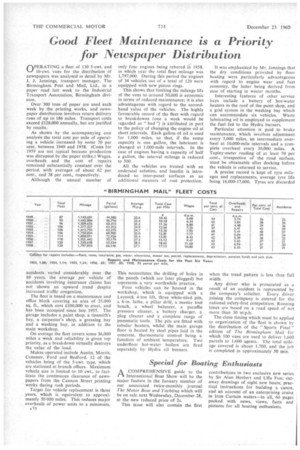Good Fleet Maintenance is a Priority for Newspaper Distribution
Page 32

If you've noticed an error in this article please click here to report it so we can fix it.
OPERATING a fleet of 130 5-cwt. and 10-cwt, vans for the distribution of newspapers was analysed in detail by Mr. J. J. Jennings, transport manager, The Birmingham Post and Mail, Ltd., in a paper read last week to the Industrial Transport Association, Birmingham division.
Over .300 tons of paper are used each week by the printing works, and newspaper distribution involves return delivery runs of up to 186 miles. Transport costs exceed £120,000 annually, but are justified by results.
As shown by the accompanying cost analysis the total cost per mile of operating a vehicle increased by some 70 per cent. between 1949 and 1958. t Costs for 1959 are not typical because production was disrupted by the paper strike.) Wages, overheads and the cost of repairs remained substantially constant over the period, with averages of about 62 per cent., and 38 per cent., respectively.
Although the annual number of accidents varied considerably over the 10 years, the average per vehicle of accidents involving insurance claims has not shown an upward trend despite increased traffic congestion.
The fleet is based on a maintenance and office block covering an area of 25,000 sq. ft., which cost £100,000 to erect, and has been occupied since late 1955. The garage includes a paint shop, a tinsmith's bay, a carpenter's shop, a greasing bay and a washing bay, in addition to the main workshop.
On average the fleet covers some 36,000 miles a week and reliability is given top priority, as a breakdown virtually destroys the value of the load.
Makes operated include Austin, Morris, Commer, Ford and Bedford, 12 of the vehicles being of the 5-cwt. type, which are stationed at branch offices. Maximum vehicle size is limited to 10 cwt., to facilitate the continuous clearance of newspapers from the Cannon Street printing works during rush periods.
Target for vehicle replacement is three years, which is equivalent to approximately 50 030 miles. This reduces major overhauls of power units to a minimum, only four engines being rebored in 1958, in which year the total fleet mileage was 1,797,000. During this period the engines of 34 vehicles out of a total of 120 were ,equipped with new piston rings.
This shows that limiting the mileage life of the vans to around 50,000 is economic in terms of reduced maintenance; it is also advantageous with regard to the secondhand value of the vehicles. The highly favourable record of the fleet with regard to breakdowns (one a week would be regarded as "bad ") is attributed in part to the policy of changing the engine oil at short intervals. Each gallon of oil is used for 1,000 miles, so that, if the sump capacity is one gallon, the lubricant is changed at 1,000-mile intervals. In the case of engines having a capacity of half a gallon, the interval mileage is reduced to 500.
All the vehicles are treated with an underseal solution, and lanolin is introduced to inter-panel surfaces as an additional measure of rust protection.
This necessitates the drilling of holes in the panels (which are later plugged) but represents a very worthwhile practice.
Four vehicles can be housed in the workshop, which is equipped with a Laycock 4-ton lift, three white-tiled pits, a 6-in, lathe, a pillar drill, a master tool bench, a wheel balancer, a paraffin pressure cleaner, a battery charger, a plug cleaner and a complete range of pneumatic tools. The pits are fitted with tubular heaters, whilst the main garage floor is heated by steel pipes laid in the concrete, thermostatic control being a function of ambient temperature. Two underfloor hot-water boilers are fired separately by Hydra oil burners. It was emphasized by Mr. Jennings that the dry conditions provided by floor heating were particularly advantageous with regard to engine wear and fuel economy, the latter being derived from ease of starting in winter months.
Interesting features of other service bays include a battery of hot-water heaters in the roof of the paint shop, and a grid system in the washing bay which can accommodate six vehicles. Waste lubricating oil is employed to supplement the fuel fed to the Hydra burners.
Particular attention is paid to brake maintenance, which involves adjustment every 3,000 miles, an intermediate overhaul at 10,000-mile intervals and a complete overhaul every 30,000 miles. A Tapley-meter reading of at least 70 per cent., irrespective of the road surface, must be obtainable after docking before the vehicle is returned to service.
A precise record is kept of tyre mileages and replacements, average tyre life being 16,000-17,000. Tyres are discarded when the tread pattern is less than full width.
Any driver who is prosecuted as a result of an accident is represented by the company's solicitor. Every driver joining the company is entered for the national safety-first competition. Running times are based on a road speed of not more than 30 m.p.h.
The close timing which must be applied to organization of the fleet is shown by the distribution of the "Sports Final" edition of The Birmingham Mail for which 100 vans are used to deliver 1,600 parcels to 1,600 agents. The total mileage covered is about 1,700, and the job is completed in approximately 50 min.




























































































